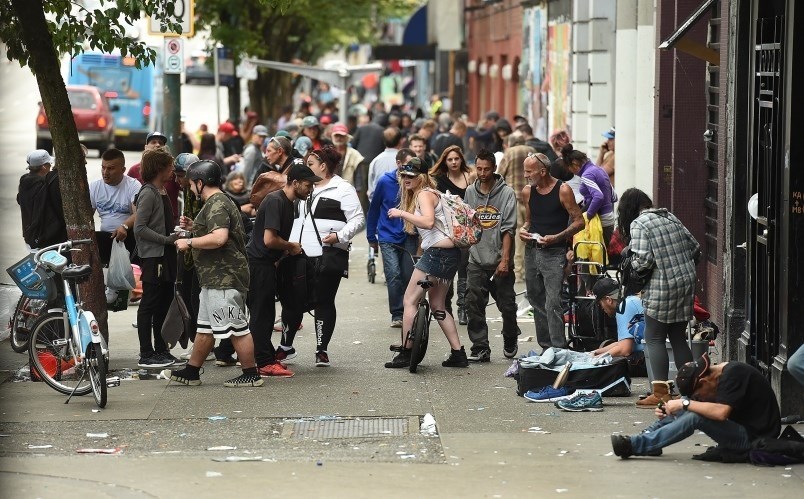New test results show that Vancouver's Downtown Eastside population may have been hit harder by COVID-19 than previously understood.
The Vancouver Infectious Diseases Centre (VIDC) - an independent nonprofit research and medical centre - regularly holds pop-up clinics in the Downtown Eastside to provide residents with a variety of clinical services. Some of these services include testing the population for HCV (Hepatitis C) and HIV, and developing appropriate treatment plans for maintaining engagement throughout the course of treatment and beyond.
While the VIDC was forced to stop its pop-up clinics due to the pandemic, it was recently allowed to resume its testing program. It added some COVID-related components to the program, which includes drawing blood from residents and sending it to the BC Centre for Disease Control (BCCDC) to test for COVID-19 antibodies.
Dr. Brian Conway, the medical director of the VIDC, told Vancouver Is Awesome in a phone interview that the results confirm that the community has not been spared from the virus.
"Let's say in 100 or so samples we found 10 or 12 - probably 12 - that have antibodies to COVID-19," said Conway. "So, to conclude from that is that COVID-19 did not miss the neighbourhood," explains Conway.
As to what extent the DTES population has been affected, Conway said it is not possible to tell exactly from the samples taken. He noted that his team conducted tests in areas where there was a high degree of transient occupation, which could appear to be a higher percentile.
"If there was COVID-19 that had been present in this neighbourhood, then the places where there is much more turnover - where individuals who are released from incarceration come to live there temporarily and at very low barrier shelters - that's where it would have been. As opposed to other facilities where these factors don't pertain."
Conway explains that this is a bit of a "contrived example" where the team went after what it thought were individuals who were most likely to become infected. That said, he remarks, "But it means that it's going to be happening."
Exploring COVID-19 in the DTES Community
This week, the VIDC team has started going back and interviewing the individuals who tested positive on their antibody tests to find out if they are at home. So far, Conway says the only thing they seem to recall is having had symptoms of opioid withdrawal more severely or more often at some point, and that could have been confused with COVID-19.
"Because the symptoms overlap significantly - in terms of if you're withdrawing from opioids - you're shaking and that could be a fever. You may have nausea or vomiting or diarrhea, which is another one of the symptoms we key in on. And you may feel a bit short of breath so that could have been interpreted as withdrawal, and that has led to more drug use to try and resolve the symptoms and that ironically possibly would have worked - in terms of making them feel better."
As to whether illness from COVID-19 could have led to a higher increase in overdose deaths, Conway says there is no data to support that theory. He notes, however, that many people who were mildly sick may have worked through it on their own, while a few who were seriously ill may not have received adequate medical attention.
"And I'm not suggesting that any of these opioid-related deaths are COVID that was missed - there's no data to suggest that. But if there were two or three that were interpreted as opioid overdoses, that were COVID, that would explain pretty much everything," adds Conway.
Conway notes that there are several reasons why COVID-19 could be spreading in the community, such as a lack of physical distancing, sanitation, and so forth, but adds that more needs to be done to prevent further spread of transmission of the virus.
"They aren't going to go from COVID to COVID testing site and line up for two hours and wait for tests. They aren't going to do that. So we have to design something, given that we know COVID is probably there and it is safe to assume it will be there on an ongoing basis. And we need to design a structure to address it," says Conway.
A Comprehensive Plan for the Downtown Eastside
Earlier this month, The Union of BC Indian Chiefs (UBCIC) says it learned that there are confirmed cases of COVID-19 throughout Vancouver’s Downtown Eastside (DTES) among residents and front line staff, with multiple cases in some locations.
In a statement, the union calls on, "all residents of the DTES, neighbours and staff, to take heightened safety precautions and get tested if they are presenting any symptoms of COVID, while ensuring that existing services continue to be used."
The UBCIC also calls on Vancouver Coastal Health and the Province to create an urgent, comprehensive plan that will target and protect the DTES’ vulnerable populations, especially Indigenous peoples.
Earlier this week, The Union Gospel Mission wrote in a post that someone at its Hastings location tested positive for the novel coronavirus. Due to privacy reasons, the shelter will not release any personal information about the person's identity. The individual is now self-isolating, receiving care, and following health authority guidelines.
V.I.A. reached out to the Portland Hotel Society but they declined to comment.




